Experiments and Modeling on the Stain-Controlled Time- and Temperature-Dependent Cyclic Ratchetting Plasticity of the Nickel-Based Superalloy IN100
Abstract
1. Introduction
1.1. Time- and Temperature-Dependent Cyclic Plasticity and Models
1.2. Strain-Controlled Ratchetting and Ratchetting Models
1.3. Material Properties and Experiments
1.4. Aims and Structure of the Paper
- Characterize the time- and temperature-dependent cyclic ratchetting plasticity of IN100 using experiments with special loading histories designed to activate distinct deformation phenomena and to generate the required data for the determination and validation of the material properties;
- Propose a strategy for the determination of the multitude of temperature-dependent material properties on the basis of the generated isothermal data;
- Validate the model and the determined material properties using non-isothermal data.
2. Time- and Temperature-Dependent Cyclic Ratchetting Plasticity Model
- thermoelastic properties E, (Poisson’s ratio is not considered in this work),
- viscous properties K and n and
- plastic properties , , b, , , , , and with .
3. Experiments and Set-Up
3.1. Material and Specimens
3.2. Testing Procedure and Data
3.2.1. Complex Low-Cycle Fatigue Tests
3.2.2. Ratchetting Tests
3.2.3. Compression Tests
3.2.4. Thermomechanical Fatigue Tests
4. Determination of Material Properties
- The fully combined Chaboche-type viscoplasticity model with Jiang ratchetting term with and backstresses in Equation (4).
4.1. Strategy
4.1.1. Thermoelastic Properties
4.1.2. Viscous Properties
4.1.3. Plastic Properties: Isotropic Hardening
4.1.4. Plastic Properties: Kinematic Hardening
4.2. Results for Isothermal Experiments
4.2.1. Complex Low-Cycle Fatigue Tests
4.2.2. Ratchetting Tests
4.2.3. Compression Tests
4.3. Model Validation on Thermomechanical Fatigue Tests
5. Discussion
6. Conclusions
- Experiments are used to activate time-dependent deformation phenomena in low-cycle fatigue tests with a preceding complex strain–time pre-program while the mean stress behavior for mean strain loading histories is investigated in ratchetting tests. Additionally, compression tests are performed to obtain insights into the deformation behavior over a large strain range;
- A step-by-step experience-based approach is presented to adjust Chaboche-type viscoplasticity models with four different levels of complexity by varying the number of and backstresses besides the consideration of the ratchetting behavior with and backstresses;
- The plasticity models and the determined temperature-dependent material properties are validated by means of in-phase and out-of-phase thermomechanical fatigue tests. The models lead to a very accurate description of the deformation behavior observed in isothermal low-cycle fatigue and thermomechanical fatigue experiments. However, not all compression tests are reasonably described;
- The ratchetting behavior is significantly overestimated by the pure Chaboche-type models incorporating no ratchetting term in the evolution of the Armstrong–Frederick hardening law. For backstresses, the ratchetting term leads to slight bending points in the stress–strain curves. Thus, backstresses should be applied to obtain smooth curves. However, the increase of the number of backstresses significantly increases the number of determinable material properties;
- The experience-based approach leads a priori to non-objective material properties, i.e., different persons would obtain miscellaneous material properties. Hence, future works should focus on quantitative analyses, e.g., by developing numerical optimization workflows, obtaining objective and physically-reasonable, temperature-dependent material properties for Chaboche-type models with multiple backstresses. These objective material properties can be used in material data spaces, e.g., to identify process–structure–properties between similar nickel-based superalloys.
Author Contributions
Funding
Institutional Review Board Statement
Informed Consent Statement
Data Availability Statement
Conflicts of Interest
Appendix A

| Temperature | °C | 300 | 750 | 850 | 950 | 1050 |
|---|---|---|---|---|---|---|
| Thermoelasticity | ||||||
| Young’s modulus E | 175 | 160 | 150 | 140 | 130 | |
| Thermal expansion coefficient | / | 13.8801 | 15.2087 | 15.9233 | 16.8240 | 17.9132 |
| Viscosity | ||||||
| Viscous reference stress K | 50 | 300 | 400 | 450 | 500 | |
| Rate sensitivity exponent n | – | 6.0 | 6.0 | 6.0 | 5.0 | 4.5 |
| Isotropic hardening | ||||||
| Initial yield stress | 540 | 480 | 280 | 120 | 40 | |
| Saturation value | 150 | 100 | 0 | 0 | 0 | |
| Hardening rate b | – | 1.5 | 2.0 | 0 | 0 | 0 |
| Kinematic hardening—backstress 1 | ||||||
| Saturation value | 165 | 165 | 165 | 140 | 80 | |
| Dynamic recovery | – | 1200 | 1200 | 1200 | 1200 | 1200 |
| Asymptotic steady state value | – | 1.0 | 1.0 | 1.0 | 1.2 | 1.5 |
| Transition rate | – | 0 | 0 | 0 | 1.0 | 1.0 |
| Static backstress recovery | 0 | 0.00025 | 0.00045 | 0.0006 | 0.0009 | |
| Kinematic hardening—backstress 2 | ||||||
| Saturation value | 330 | 330 | 330 | 280 | 160 | |
| Dynamic recovery | – | 100 | 100 | 100 | 100 | 100 |
| Asymptotic steady state value | – | 1.0 | 1.0 | 1.0 | 1.2 | 1.5 |
| Transition rate | – | 0 | 0 | 0 | 1.0 | 1.0 |
| Static backstress recovery | 0 | 0.00025 | 0.00045 | 0.0006 | 0.0009 | |
| Temperature | °C | 300 | 750 | 850 | 950 | 1050 |
|---|---|---|---|---|---|---|
| Thermoelasticity | ||||||
| Young’s modulus E | 175 | 160 | 150 | 140 | 130 | |
| Thermal expansion coefficient | / | 13.8801 | 15.2087 | 15.9233 | 16.8240 | 17.9132 |
| Viscosity | ||||||
| Viscous reference stress K | 50 | 300 | 400 | 450 | 500 | |
| Rate sensitivity exponent n | – | 6.0 | 6.0 | 6.0 | 5.0 | 4.5 |
| Isotropic hardening | ||||||
| Initial yield stress | 540 | 480 | 280 | 120 | 40 | |
| Saturation value | 150 | 100 | 0 | 0 | 0 | |
| Hardening rate b | – | 1.5 | 2.0 | 0 | 0 | 0 |
| Kinematic hardening—backstress 1 | ||||||
| Saturation value | 80 | 80 | 80 | 60 | 40 | |
| Dynamic recovery | – | 3000 | 3000 | 3000 | 3000 | 3000 |
| Asymptotic steady state value | – | 1.0 | 1.0 | 1.0 | 1.2 | 1.5 |
| Transition rate | – | 0 | 0 | 0 | 1.0 | 1.0 |
| Static backstress recovery | 0 | 0.0004 | 0.0005 | 0.0006 | 0.0007 | |
| Kinematic hardening—backstress 2 | ||||||
| Saturation value | 60 | 60 | 60 | 50 | 35 | |
| Dynamic recovery | – | 1000 | 1000 | 1000 | 1000 | 1000 |
| Asymptotic steady state value | – | 1.0 | 1.0 | 1.0 | 1.2 | 1.5 |
| Transition rate | – | 0 | 0 | 0 | 1.0 | 1.0 |
| Static backstress recovery | 0 | 0.0004 | 0.0005 | 0.0006 | 0.0007 | |
| Kinematic hardening—backstress 3 | ||||||
| Saturation value | 120 | 120 | 120 | 120 | 75 | |
| Dynamic recovery | – | 250 | 250 | 250 | 250 | 250 |
| Asymptotic steady state value | – | 1.0 | 1.0 | 1.0 | 1.2 | 1.5 |
| Transition rate | – | 0 | 0 | 0 | 1.0 | 1.0 |
| Static backstress recovery | 0 | 0.0004 | 0.0005 | 0.0006 | 0.0007 | |
| Kinematic hardening—backstress 4 | ||||||
| Saturation value | 140 | 140 | 140 | 140 | 85 | |
| Dynamic recovery | – | 50 | 50 | 50 | 50 | 50 |
| Asymptotic steady state value | – | 1.0 | 1.0 | 1.0 | 1.2 | 1.5 |
| Transition rate | – | 0 | 0 | 0 | 1.0 | 1.0 |
| Static backstress recovery | 0 | 0.0004 | 0.0005 | 0.0006 | 0.0007 | |
| Kinematic hardening—backstress 5 | ||||||
| Saturation value | 180 | 180 | 180 | 165 | 115 | |
| Dynamic recovery | – | 2.5 | 2.5 | 2.5 | 2.5 | 2.5 |
| Asymptotic steady state value | – | 1.0 | 1.0 | 1.0 | 1.2 | 1.5 |
| Transition rate | – | 0 | 0 | 0 | 1.0 | 1.0 |
| Static backstress recovery | 0 | 0.0004 | 0.0005 | 0.0006 | 0.0007 | |
| Temperature | °C | 300 | 750 | 850 | 950 | 1050 |
|---|---|---|---|---|---|---|
| Thermoelasticity | ||||||
| Young’s modulus E | 175 | 160 | 150 | 140 | 130 | |
| Thermal expansion coefficient | / | 13.8801 | 15.2087 | 15.9233 | 16.8240 | 17.9132 |
| Viscosity | ||||||
| Viscous reference stress K | 50 | 300 | 400 | 450 | 500 | |
| Rate sensitivity exponent n | – | 6.0 | 6.0 | 6.0 | 5.0 | 4.5 |
| Isotropic hardening | ||||||
| Initial yield stress | 540 | 480 | 280 | 120 | 40 | |
| Saturation value | 150 | 100 | 0 | 0 | 0 | |
| Hardening rate b | – | 1.5 | 2.0 | 0 | 0 | 0 |
| Kinematic hardening—backstress 1 | ||||||
| Saturation value | 80 | 80 | 80 | 60 | 40 | |
| Dynamic recovery | – | 3000 | 3000 | 3000 | 3000 | 3000 |
| Asymptotic steady state value | – | 1.0 | 1.0 | 1.0 | 1.2 | 1.5 |
| Transition rate | – | 0 | 0 | 0 | 1.0 | 1.0 |
| Static backstress recovery | 0 | 0.0004 | 0.0005 | 0.0006 | 0.0007 | |
| Ratchetting exponent | – | 20 | 20 | 10 | 4 | 2 |
| Kinematic hardening—backstress 2 | ||||||
| Saturation value | 60 | 60 | 60 | 50 | 35 | |
| Dynamic recovery | – | 1000 | 1000 | 1000 | 1000 | 1000 |
| Asymptotic steady state value | – | 1.0 | 1.0 | 1.0 | 1.2 | 1.5 |
| Transition rate | – | 0 | 0 | 0 | 1.0 | 1.0 |
| Static backstress recovery | 0 | 0.0004 | 0.0005 | 0.0006 | 0.0007 | |
| Ratchetting exponent | – | 25 | 25 | 15 | 7 | 3 |
| Kinematic hardening—backstress 3 | ||||||
| Saturation value | 110 | 110 | 110 | 110 | 75 | |
| Dynamic recovery | – | 200 | 200 | 200 | 200 | 200 |
| Asymptotic steady state value | – | 1.0 | 1.0 | 1.0 | 1.2 | 1.5 |
| Transition rate | – | 0 | 0 | 0 | 1.0 | 1.0 |
| Static backstress recovery | 0 | 0.0004 | 0.0005 | 0.0006 | 0.0007 | |
| Ratchetting exponent | – | 50 | 50 | 25 | 10 | 5 |
| Kinematic hardening—backstress 4 | ||||||
| Saturation value | 125 | 125 | 125 | 120 | 85 | |
| Dynamic recovery | – | 25 | 25 | 25 | 25 | 25 |
| Asymptotic steady state value | – | 1.0 | 1.0 | 1.0 | 1.2 | 1.5 |
| Transition rate | – | 0 | 0 | 0 | 1.0 | 1.0 |
| Static backstress recovery | 0 | 0.0004 | 0.0005 | 0.0006 | 0.0007 | |
| Ratchetting exponent | – | 100 | 100 | 50 | 15 | 7.5 |
| Kinematic hardening—backstress 5 | ||||||
| Saturation value | 140 | 140 | 140 | 140 | 115 | |
| Dynamic recovery | – | 2.5 | 2.5 | 2.5 | 2.5 | 2.5 |
| Asymptotic steady state value | – | 1.0 | 1.0 | 1.0 | 1.2 | 1.5 |
| Transition rate | – | 0 | 0 | 0 | 1.0 | 1.0 |
| Static backstress recovery | 0 | 0.0004 | 0.0005 | 0.0006 | 0.0007 | |
| Ratchetting exponent | – | 200 | 200 | 100 | 20 | 10 |
| Temperature | °C | 300 | 750 | 850 | 950 | 1050 |
|---|---|---|---|---|---|---|
| Thermoelasticity | ||||||
| Young’s modulus E | 175 | 160 | 150 | 140 | 130 | |
| Thermal expansion coefficient | / | 13.8801 | 15.2087 | 15.9233 | 16.8240 | 17.9132 |
| Viscosity | ||||||
| Viscous reference stress K | 50 | 300 | 400 | 450 | 500 | |
| Rate sensitivity exponent n | – | 6.0 | 6.0 | 6.0 | 5.0 | 4.5 |
| Isotropic hardening | ||||||
| Initial yield stress | 540 | 480 | 280 | 120 | 40 | |
| Saturation value | 150 | 100 | 0 | 0 | 0 | |
| Hardening rate b | – | 1.5 | 2.0 | 0 | 0 | 0 |
| Kinematic hardening—backstress 1 | ||||||
| Saturation value | 80 | 80 | 80 | 60 | 40 | |
| Dynamic recovery | – | 3000 | 3000 | 3000 | 3000 | 3000 |
| Asymptotic steady state value | – | 1.0 | 1.0 | 1.0 | 1.2 | 1.5 |
| Transition rate | – | 0 | 0 | 0 | 1.0 | 1.0 |
| Static backstress recovery | 0 | 0.0004 | 0.0007 | 0.0009 | 0.001 | |
| Ratchetting exponent | – | 20 | 20 | 10 | 4 | 2 |
| Kinematic hardening—backstress 2 | ||||||
| Saturation value | 60 | 60 | 60 | 50 | 35 | |
| Dynamic recovery | – | 1000 | 1000 | 1000 | 1000 | 1000 |
| Asymptotic steady state value | – | 1.0 | 1.0 | 1.0 | 1.2 | 1.5 |
| Transition rate | – | 0 | 0 | 0 | 1.0 | 1.0 |
| Static backstress recovery | 0 | 0.0004 | 0.0007 | 0.0009 | 0.001 | |
| Ratchetting exponent | – | 25 | 25 | 12.5 | 6 | 3 |
| Kinematic hardening—backstress 3 | ||||||
| Saturation value | 60 | 60 | 60 | 50 | 35 | |
| Dynamic recovery | – | 400 | 400 | 400 | 400 | 400 |
| Asymptotic steady state value | – | 1.0 | 1.0 | 1.0 | 1.2 | 1.5 |
| Transition rate | – | 0 | 0 | 0 | 1.0 | 1.0 |
| Static backstress recovery | 0 | 0.0004 | 0.0007 | 0.0009 | 0.001 | |
| Ratchetting exponent | – | 30 | 30 | 15 | 8 | 4 |
| Kinematic hardening—backstress 4 | ||||||
| Saturation value | 40 | 40 | 40 | 40 | 30 | |
| Dynamic recovery | – | 150 | 150 | 150 | 150 | 150 |
| Asymptotic steady state value | – | 1.0 | 1.0 | 1.0 | 1.2 | 1.5 |
| Transition rate | – | 0 | 0 | 0 | 1.0 | 1.0 |
| Static backstress recovery | 0 | 0.0004 | 0.0007 | 0.0009 | 0.001 | |
| Ratchetting exponent | – | 50 | 50 | 25 | 10 | 5 |
| Kinematic hardening—backstress 5 | ||||||
| Saturation value | 40 | 40 | 40 | 40 | 25 | |
| Dynamic recovery | – | 75 | 75 | 75 | 75 | 75 |
| Asymptotic steady state value | – | 1.0 | 1.0 | 1.0 | 1.2 | 1.5 |
| Transition rate | – | 0 | 0 | 0 | 1.0 | 1.0 |
| Static backstress recovery | 0 | 0.0004 | 0.0007 | 0.0009 | 0.001 | |
| Ratchetting exponent | – | 100 | 100 | 50 | 20 | 10 |
| Kinematic hardening—backstress 6 | ||||||
| Saturation value | 40 | 40 | 40 | 40 | 25 | |
| Dynamic recovery | – | 40 | 40 | 40 | 40 | 40 |
| Asymptotic steady state value | – | 1.0 | 1.0 | 1.0 | 1.2 | 1.5 |
| Transition rate | – | 0 | 0 | 0 | 1.0 | 1.0 |
| Static backstress recovery | 0 | 0.0004 | 0.0007 | 0.0009 | 0.001 | |
| Ratchetting exponent | – | 100 | 100 | 50 | 20 | 10 |
| Kinematic hardening—backstress 7 | ||||||
| Saturation value | 40 | 40 | 40 | 40 | 25 | |
| Dynamic recovery | – | 20 | 20 | 20 | 20 | 20 |
| Asymptotic steady state value | – | 1.0 | 1.0 | 1.0 | 1.2 | 1.5 |
| Transition rate | – | 0 | 0 | 0 | 1.0 | 1.0 |
| Static backstress recovery | 0 | 0.0004 | 0.0007 | 0.0009 | 0.001 | |
| Ratchetting exponent | – | 100 | 100 | 50 | 20 | 10 |
| Kinematic hardening—backstress 8 | ||||||
| Saturation value | 40 | 40 | 40 | 40 | 25 | |
| Dynamic recovery | – | 10 | 10 | 10 | 10 | 10 |
| Asymptotic steady state value | – | 1.0 | 1.0 | 1.0 | 1.2 | 1.5 |
| Transition rate | – | 0 | 0 | 0 | 1.0 | 1.0 |
| Static backstress recovery | 0 | 0.0004 | 0.0007 | 0.0009 | 0.001 | |
| Ratchetting exponent | – | 200 | 200 | 100 | 40 | 20 |
| Kinematic hardening—backstress 9 | ||||||
| Saturation value | 40 | 40 | 40 | 40 | 25 | |
| Dynamic recovery | – | 5.0 | 5.0 | 5.0 | 5.0 | 5.0 |
| Asymptotic steady state value | – | 1.0 | 1.0 | 1.0 | 1.2 | 1.5 |
| Transition rate | – | 0 | 0 | 0 | 1.0 | 1.0 |
| Static backstress recovery | 0 | 0.0004 | 0.0007 | 0.0009 | 0.001 | |
| Ratchetting exponent | – | 500 | 500 | 250 | 100 | 50 |
| Kinematic hardening—backstress 10 | ||||||
| Saturation value | 60 | 60 | 60 | 60 | 40 | |
| Dynamic recovery | – | 2.5 | 2.5 | 2.5 | 2.5 | 2.5 |
| Asymptotic steady state value | – | 1.0 | 1.0 | 1.0 | 1.2 | 1.5 |
| Transition rate | – | 0 | 0 | 0 | 1.0 | 1.0 |
| Static backstress recovery | 0 | 0.0004 | 0.0007 | 0.0009 | 0.001 | |
| Ratchetting exponent | – | 1000 | 1000 | 500 | 200 | 100 |
References
- Nourin, F.N.; Amano, R.S. Review of Gas Turbine Internal Cooling Improvement Technology. J. Energy Resour. Technol. 2020, 143. [Google Scholar] [CrossRef]
- Mazur, Z.; Luna-Ramírez, A.; Juárez-Islas, J.; Campos-Amezcua, A. Failure analysis of a gas turbine blade made of Inconel 738LC alloy. Eng. Fail. Anal. 2005, 12, 474–486. [Google Scholar] [CrossRef]
- Chaboche, J. Time-independent constitutive theories for cyclic plasticity. Int. J. Plast. 1986, 2, 149–188. [Google Scholar] [CrossRef]
- Chaboche, J.L. Constitutive equations for cyclic plasticity and cyclic viscoplasticity. Int. J. Plast. 1989, 5, 247–302. [Google Scholar] [CrossRef]
- Chaboche, J.L. A review of some plasticity and viscoplasticity constitutive theories. Int. J. Plast. 2008, 24, 1642–1693. [Google Scholar] [CrossRef]
- Armstrong, P.J.; Frederick, C.O. A Mathematical Representation of the Multiaxial Bauschinger Effect; Technical Report RD/B/N731; Central Electricity Generating Board: Berkeley, UK, 1966. [Google Scholar]
- Frederick, C.O.; Armstrong, P.J. A mathematical representation of the multiaxial Bauschinger effect. Mater. High Temp. 2007, 24, 1–26. [Google Scholar] [CrossRef]
- Chaboche, J.L. Cyclic Viscoplastic Constitutive Equations, Part I: A Thermodynamically Consistent Formulation. J. Appl. Mech. 1993, 60, 813–821. [Google Scholar] [CrossRef]
- Cailletaud, G.; Quilici, S.; Azzouz, F.; Chaboche, J.L. A dangerous use of the fading memory term for non linear kinematic models at variable temperature. Eur. J. Mech.–A/Solids 2015, 54, 24–29. [Google Scholar] [CrossRef]
- Ohno, N.; Wang, J.D. Transformation of a nonlinear kinematic hardening rule to a multisurface form under isothermal and nonisothermal conditions. Int. J. Plast. 1991, 7, 879–891. [Google Scholar] [CrossRef]
- Ohno, N.; Wang, J. Nonisothermal constitutive modeling of inelasticity based on bounding surface. Nucl. Eng. Des. 1992, 133, 369–381. [Google Scholar] [CrossRef]
- Farrahi, G.H.; Shamloo, A.; Felfeli, M.; Azadi, M. Numerical simulations of cyclic behaviors in light alloys under isothermal and thermo-mechanical fatigue loadings. Mater. Des. 2014, 56, 245–253. [Google Scholar] [CrossRef]
- Seifert, T.; Hazime, R.; Chang, C.C.; Hu, C. Constitutive Modeling and Thermomechanical Fatigue Life Predictions of A356-T6 Aluminum Cylinder Heads Considering Ageing Effects. In Proceedings of the WCX SAE World Congress Experience, Detroit, MI, USA, 9–11 April 2019; SAE International: Warrendale, PA, USA, 2019. [Google Scholar] [CrossRef]
- Hosseini, E.; Holdsworth, S.R.; Kühn, I.; Mazza, E. Temperature dependent representation for Chaboche kinematic hardening model. Mater. High Temp. 2015, 32, 404–412. [Google Scholar] [CrossRef]
- Hyde, C.J.; Sun, W.; Leen, S.B. Cyclic thermo-mechanical material modelling and testing of 316 stainless steel. Int. J. Press. Vessel. Pip. 2010, 87, 365–372. [Google Scholar] [CrossRef]
- Ohmenhäuser, F.; Schwarz, C.; Thalmair, S.; Evirgen, H.S. Constitutive modeling of the thermo-mechanical fatigue and lifetime behavior of the cast steel 1.4849. Mater. Des. 2014, 64, 631–639. [Google Scholar] [CrossRef]
- Seifert, T.; Schweizer, C.; Schlesinger, M.; Möser, M.; Eibl, M. Thermomechanical fatigue of 1.4849 cast steel–Experiments and life prediction using a fracture mechanics approach: Dedicated to Professor Dr. Hermann Riedel on the occasion of his 65th birthday. Int. J. Mater. Res. 2010, 101, 942–950. [Google Scholar] [CrossRef]
- Bartošák, M.; Španiel, M.; Doubrava, K. Unified viscoplasticity modelling for a SiMo 4.06 cast iron under isothermal low-cycle fatigue-creep and thermo-mechanical fatigue loading conditions. Int. J. Fatigue 2020, 136, 105566. [Google Scholar] [CrossRef]
- Seifert, T.; Hazime, R.; Dropps, S. TMF Life Prediction of High Temperature Components Made of Cast Iron HiSiMo: Part II: Multiaxial Implementation and Component Assessment. SAE Int. J. Mater. Manuf. 2014, 7, 421–431. [Google Scholar] [CrossRef]
- Rekun, I.; Seifert, T.; Roland, J. Determination of stable and robust material properties for the assessment of thermomechanically loaded components of rocket engines with viscoplastic constitutive equations, 2016. In Proceedings of the European Conference on Spacecraft Structures, Materials and Environmental Testing (ECSSMET), Toulouse, France, 27–30 September 2016. [Google Scholar]
- Ahmed, R.; Barrett, P.R.; Hassan, T. Constitutive Modeling of Haynes 230 for Anisothermal Thermo-Mechanical Fatigue and Multiaxial Creep-Ratcheting Responses. In Proceedings of the Pressure Vessels and Piping Conference, Paris, France, 14–18 July 2013; Volume 6B: Materials and Fabrication. p. V06BT06A027. [Google Scholar] [CrossRef]
- Maier, G.; Riedel, H.; Seifert, T.; Klöwer, J.; Mohmann, R. Time and Temperature Dependent Cyclic Plasticity and Fatigue Crack Growth of the Nickel-Base Alloy617B – Experiments and Models. In Proceedings of the Euro Superalloys, Pittsburgh, PA, USA, 10–13 October 2010; Advanced Materials Research. Trans Tech Publications Ltd.: Bäch, Switzerland, 2011; Volume 278, pp. 369–374. [Google Scholar] [CrossRef]
- Morch, H.; Duchêne, L.; Harzallah, R.; Tuninetti, V.; Habraken, A.M. Efficient temperature dependence of parameters for thermo-mechanical finite element modeling of alloy 230. Eur. J. Mech.–A/Solids 2021, 85, 104116. [Google Scholar] [CrossRef]
- Sun, J.; Yuan, H. Cyclic plasticity modeling of nickel-based superalloy Inconel 718 under multi-axial thermo-mechanical fatigue loading conditions. Int. J. Fatigue 2019, 119, 89–101. [Google Scholar] [CrossRef]
- Thiele, M.; Eckmann, S.; Huang, M.; Gampe, U.; Fischer, K.A.; Schlesinger, M. Experimental and Numerical Investigation on the Influence of Thermally Induced Stress Gradients on Fatigue Life of the Nickel-Base Alloy Mar-M247. In Proceedings of the ASME Turbo Expo 2019: Turbomachinery Technical Conference and Exposition, Volume 7A: Structures and Dynamics. Phoenix. Phoenix, AZ, USA, 17–21 June 2019; ASME: New York City, NY, USA; p. V07AT31A013. [Google Scholar] [CrossRef]
- Yaguchi, M.; Yamamoto, M.; Ogata, T. A viscoplastic constitutive model for nickel-base superalloy, part 2: Modeling under anisothermal conditions. Int. J. Plast. 2002, 18, 1111–1131. [Google Scholar] [CrossRef]
- Döring, R.; Hoffmeyer, J.; Seeger, T.; Vormwald, M. A plasticity model for calculating stress–strain sequences under multiaxial nonproportional cyclic loading. Comput. Mater. Sci. 2003, 28, 587–596. [Google Scholar] [CrossRef]
- Andrade, P.; Carpenter, V.; Masal, R. Modeling of Strain Range Memory Effect to Capture Nonlinear Behavior in Non-masing Metals to Accurately Predict Life. In Proceedings of the Fatigue, Durability, and Fracture Mechanics; Seetharamu, S., Jagadish, T., Malagi, R., Eds.; Springer: Singapore, 2021; pp. 135–142. [Google Scholar]
- Haupt, P.; Kamlah, M.; Tsakmakis, C. Continuous representation of hardening properties in cyclic plasticity. Int. J. Plast. 1992, 8, 803–817. [Google Scholar] [CrossRef]
- Cao, W.; Yang, J.; Zhang, H. Unified constitutive modeling of Haynes 230 including cyclic hardening/softening and dynamic strain aging under isothermal low-cycle fatigue and fatigue-creep loads. Int. J. Plast. 2021, 138, 102922. [Google Scholar] [CrossRef]
- Lubich, S.; Fischer, C.; Schilli, S.; Seifert, T. Microstructure-sensitive finite-element analysis of crack-tip opening displacement and crack closure for microstructural short fatigue cracks. Int. J. Fatigue 2022, 162, 106911. [Google Scholar] [CrossRef]
- Kang, G.; Kan, Q. 9–Application of cyclic plasticity for modeling ratcheting in metals. In Cyclic Plasticity of Metals; Jahed, H., Roostaei, A.A., Eds.; Elsevier Series on Plasticity of Materials; Elsevier: Amsterdam, The Netherlands, 2022; pp. 325–355. [Google Scholar] [CrossRef]
- Ohno, N.; Wang, J.D. Kinematic hardening rules with critical state of dynamic recovery, part I: Formulation and basic features for ratchetting behavior. Int. J. Plast. 1993, 9, 375–390. [Google Scholar] [CrossRef]
- Jiang, Y.; Sehitoglu, H. Modeling of Cyclic Ratchetting Plasticity, Part I: Development of Constitutive Relations. J. Appl. Mech. 1996, 63, 720–725. [Google Scholar] [CrossRef]
- Abdel-Karim, M.; Ohno, N. Kinematic hardening model suitable for ratchetting with steady-state. Int. J. Plast. 2000, 16, 225–240. [Google Scholar] [CrossRef]
- Ohno, N.; Yamamoto, R.; Sasaki, T.; Okumura, D. Resetting scheme for plastic strain surface in constitutive modeling of cyclic plasticity. ZAMM-J. Appl. Math. Mech./Z. Für Angew. Math. Und Mech. 2018, 98, 518–531. [Google Scholar] [CrossRef]
- Ohno, N.; Nakamoto, H.; Morimatsu, Y.; Hamada, T.; Okumura, D. Resetting scheme for plastic strain range evaluation in cyclic plasticity: Experimental verification. Int. J. Plast. 2019, 123, 56–69. [Google Scholar] [CrossRef]
- Ohno, N.; Nakamoto, H.; Morimatsu, Y.; Okumura, D. Modeling of cyclic hardening and evaluation of plastic strain range in the presence of pre-loading and ratcheting. Int. J. Plast. 2021, 145, 103074. [Google Scholar] [CrossRef]
- Yu, D.; Chen, G.; Yu, W.; Li, D.; Chen, X. Visco-plastic constitutive modeling on Ohno–Wang kinematic hardening rule for uniaxial ratcheting behavior of Z2CND18.12N steel. Int. J. Plast. 2012, 28, 88–101. [Google Scholar] [CrossRef]
- Lee, C.H.; Do, V.N.V.; Chang, K.H. Analysis of uniaxial ratcheting behavior and cyclic mean stress relaxation of a duplex stainless steel. Int. J. Plast. 2014, 62, 17–33. [Google Scholar] [CrossRef]
- Wu, D.L.; Xuan, F.Z.; Guo, S.J.; Zhao, P. Uniaxial mean stress relaxation of 9–12% Cr steel at high temperature: Experiments and viscoplastic constitutive modeling. Int. J. Plast. 2016, 77, 156–173. [Google Scholar] [CrossRef]
- Van Do, V.N.; Lee, C.H.; Chang, K.H. A constitutive model for uniaxial/multiaxial ratcheting behavior of a duplex stainless steel. Mater. Des. (1980–2015) 2015, 65, 1161–1171. [Google Scholar] [CrossRef]
- Feigenbaum, H.P.; Dugdale, J.; Dafalias, Y.F.; Kourousis, K.I.; Plesek, J. Multiaxial ratcheting with advanced kinematic and directional distortional hardening rules. Int. J. Solids Struct. 2012, 49, 3063–3076. [Google Scholar] [CrossRef]
- Okorokov, V.; Gorash, Y.; Mackenzie, D.; van Rijswick, R. New formulation of nonlinear kinematic hardening model, Part II: Cyclic hardening/softening and ratcheting. Int. J. Plast. 2019, 122, 244–267. [Google Scholar] [CrossRef]
- Wang, R.; Zhang, B.; Hu, D.; Jiang, K.; Mao, J.; Jing, F. Cyclic viscoplastic deformation modeling of a nickel-based single crystal superalloy with [001] orientation. MATEC Web Conf. 2018, 165, 19005. [Google Scholar] [CrossRef][Green Version]
- Zhang, B.; Wang, R.; Hu, D.; Jiang, K.; Hao, X.; Mao, J.; Jing, F. Constitutive modelling of ratcheting behaviour for nickel-based single crystal superalloy under thermomechanical fatigue loading considering microstructure evolution. Int. J. Fatigue 2020, 139, 105786. [Google Scholar] [CrossRef]
- Ahmed, R.; Barrett, P.R.; Hassan, T. Unified viscoplasticity modeling for isothermal low-cycle fatigue and fatigue-creep stress–strain responses of Haynes 230. Int. J. Solids Struct. 2016, 88–89, 131–145. [Google Scholar] [CrossRef]
- Seifert, T. Ein komplexes LCF-Versuchsprogramm zur schnellen und günstigen Werkstoffparameteridentifizierung. In Proceedings of the Werkstoffprüfung, Bad Neuenahr, Germany, 7–8 December 2006; Borsutzki, M., Geisler, S., Eds.; Verlag Stahleisen: Düsseldorf, Germany, 2006; pp. 409–414. [Google Scholar]
- Jiang, Y.; Sehitoglu, H. Modeling of Cyclic Ratchetting Plasticity, Part II: Comparison of Model Simulations With Experiments. J. Appl. Mech. 1996, 63, 726–733. [Google Scholar] [CrossRef]
- ISO 12106; ISO 12106:2003(E): Metallic materials—Fatigue testing—Axial-strain-controlled method. International Organization for Standardization. ISO Copyright Office: Geneva, Switzerland, 2003.
- Siebel, E.; Gaier, M. Untersuchungen über den Einfluss der Oberflächenbeschaffenheit auf die Dauerschwingfestigkeit metallischer Bauteile. VDI-Z 1956, 98, 1715–1723. [Google Scholar]
- Schenk, T.; Seifert, T.; Brehm, H. A Simple Analogous Model for the Determination of Cyclic Plasticity Parameters of Thin Wires to Model Wire Drawing. J. Eng. Mater. Technol. 2007, 129, 488–495. [Google Scholar] [CrossRef]
- Lian, J.; Wu, J.; Münstermann, S. Evaluation of the cold formability of high-strength low-alloy steel plates with the modified Bai–Wierzbicki damage model. Int. J. Damage Mech. 2015, 24, 383–417. [Google Scholar] [CrossRef]
- Tritschler, M.; Butz, A.; Helm, D.; Falkinger, G.; Kiese, J. Experimental analysis and modeling of the anisotropic response of titanium alloy Ti-X for quasi-static loading at room temperature. Int. J. Mater. Form. 2014, 7, 259–273. [Google Scholar] [CrossRef]
- Zhuang, X.; Zhao, Z.; Li, H.; Xiang, H. Experimental Methodology for Obtaining the Flow Curve of Sheet Materials in a Wide Range of Strains. Steel Res. Int. 2012, 84, 146–154. [Google Scholar] [CrossRef]
- Ramberg, W.; Osgood, W.R. Description of Stress-Strain Curves by Three Parameters; Technical Report NACA-TN-902; National Advisory Committee For Aeronautics: Washington, DC, USA, 1943. [Google Scholar]
- ISO 12111; ISO 12111:2011(E): Metallic materials —Fatigue Testing—Strain-controlled Thermomechanical Fatigue Testing Method. International Organization for Standardization, ISO Copyright Office: Geneva, Switzerland, 2011.
- Fossum, A.F. Parameter Estimation for an Internal Variable Model Using Nonlinear Optimization and Analytical/Numerical Response Sensitivities. J. Eng. Mater. Technol. 1997, 119, 337–345. [Google Scholar] [CrossRef]
- Tong, J.; Vermeulen, B. The description of cyclic plasticity and viscoplasticity of waspaloy using unified constitutive equations. Int. J. Fatigue 2003, 25, 413–420. [Google Scholar] [CrossRef]
- Bartsch, H.; Granacher, J. Langzeitkriechen–Ermittlung und Beschreibung des Langzeitkriechverhaltens hochwarmfester Gasturbinenwerkstoffe; Technical Report 344; Research Association for Combustion Engines eV: Frankfurt am Main, Germany, 1982. [Google Scholar]
- Granacher, J.; Pfenning, A. Kriechgleichungen II–Rechnergestützte Beschreibung des Kriechverhaltens ausgewählter hochwarmfester Legierungen; Technical Report 534; Research Association for Combustion Engines eV: Frankfurt am Main, Germany, 1991. [Google Scholar]
- Granacher, J.; Pfenning, A. Kriechbeschreibung–Optimierung und Verifizierung von Kriechgleichungen für Hochtemperaturwerkstoffe; Technical Report 592; Research Association for Combustion Engines eV: Frankfurt am Main, Germany, 1994. [Google Scholar]
- Granacher, J.; Preußler, T. Kriechgleichungen I–Numerische Beschreibung des Kriechverhaltens hochwarmfester Legierungen; Technical Report 375; Research Association for Combustion Engines eV: Frankfurt am Main, Germany, 1988. [Google Scholar]
- Norton, F.H. The Creep of Steel at High Temperatures; McGraw-Hill Book Company, Incorporated: New York, NY, USA, 1929; Volume 35. [Google Scholar]
- Mahnken, R.; Stein, E. Parameter identification for viscoplastic models based on analytical derivatives of a least-squares functional and stability investigations. Int. J. Plast. 1996, 12, 451–479. [Google Scholar] [CrossRef]
- Kreißig, R.; Benedix, U.; Görke, U.J. Statistical aspects of the identification of material parameters for elasto-plastic models. Arch. Appl. Mech. 2001, 71, 123–134. [Google Scholar] [CrossRef]


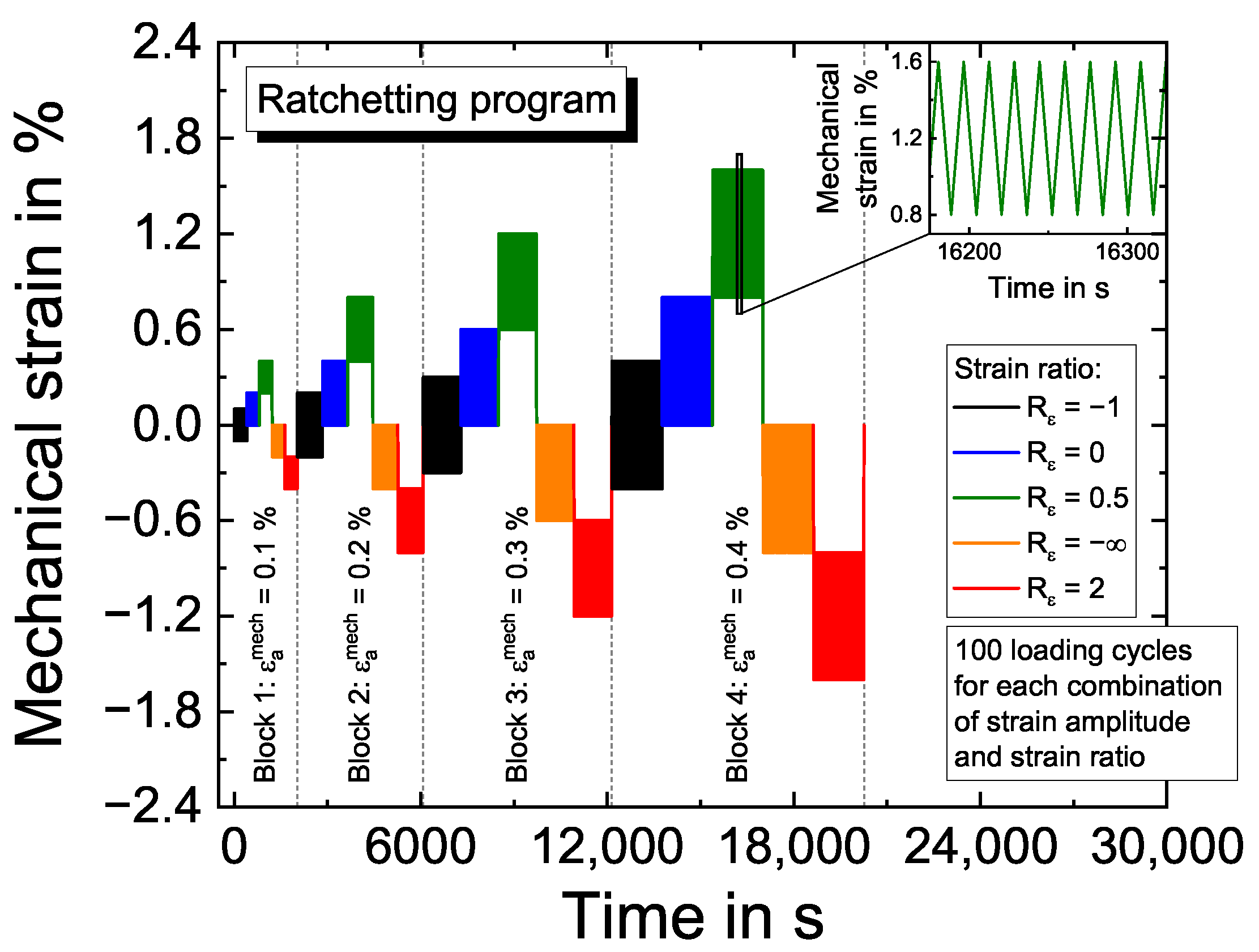
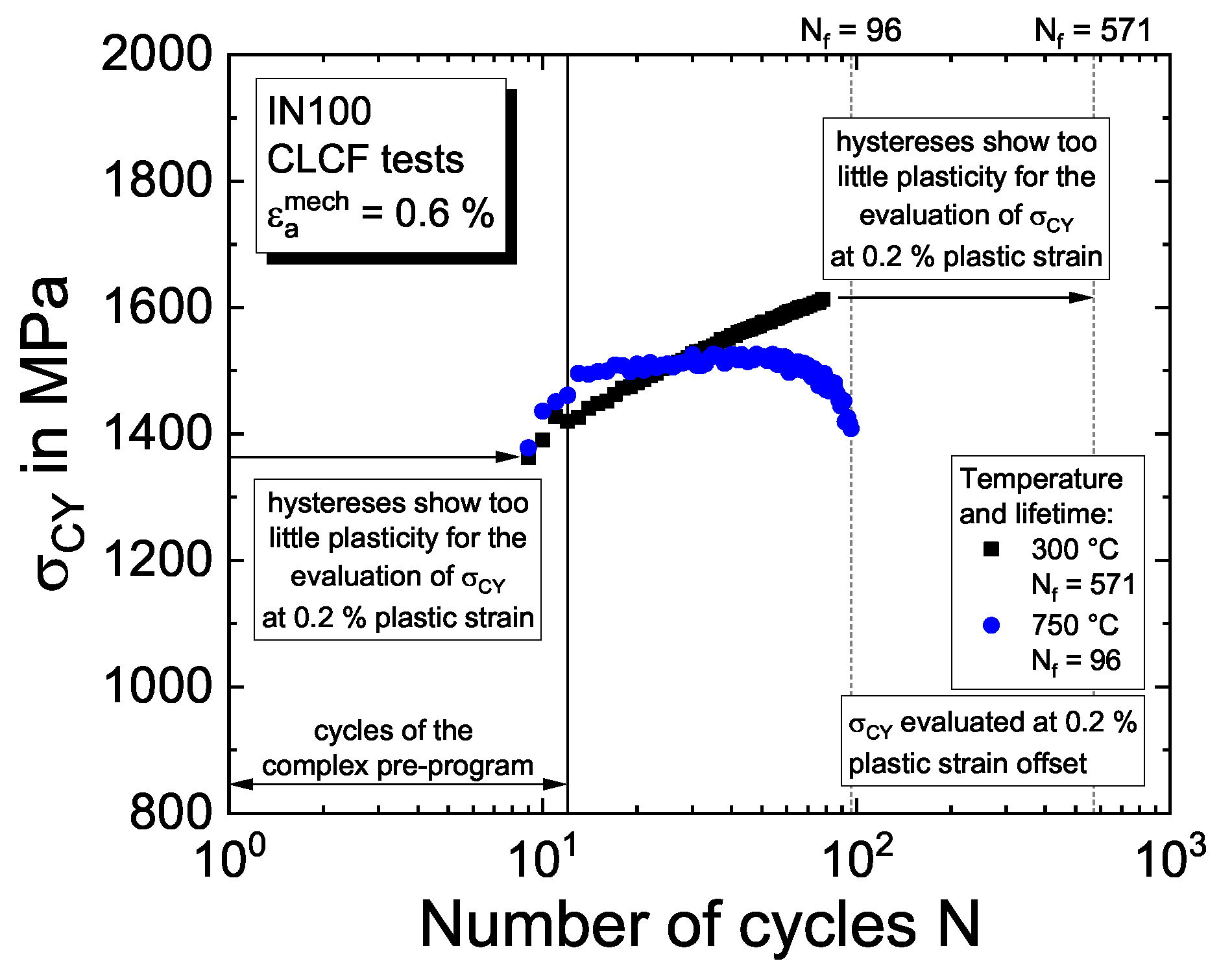
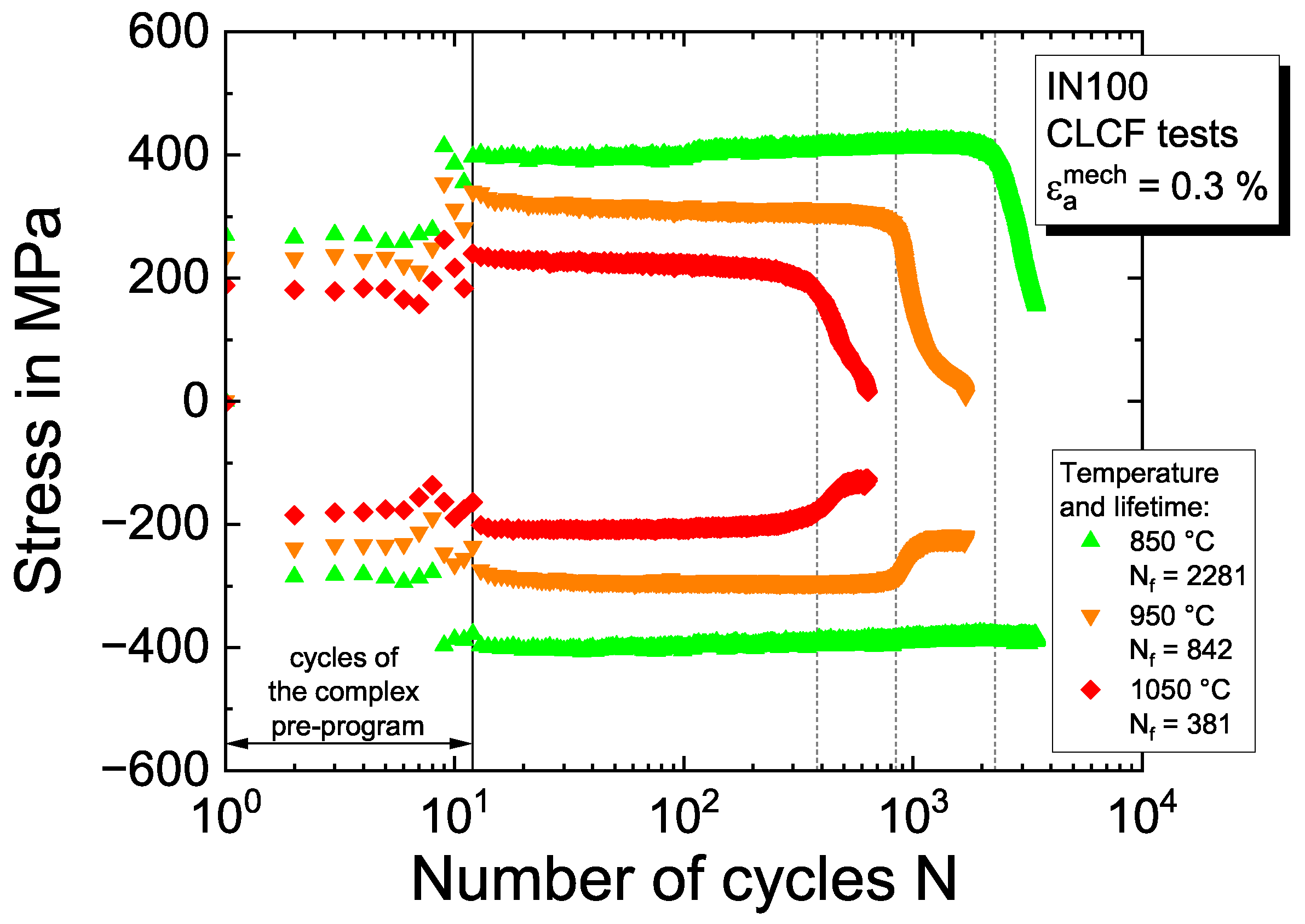

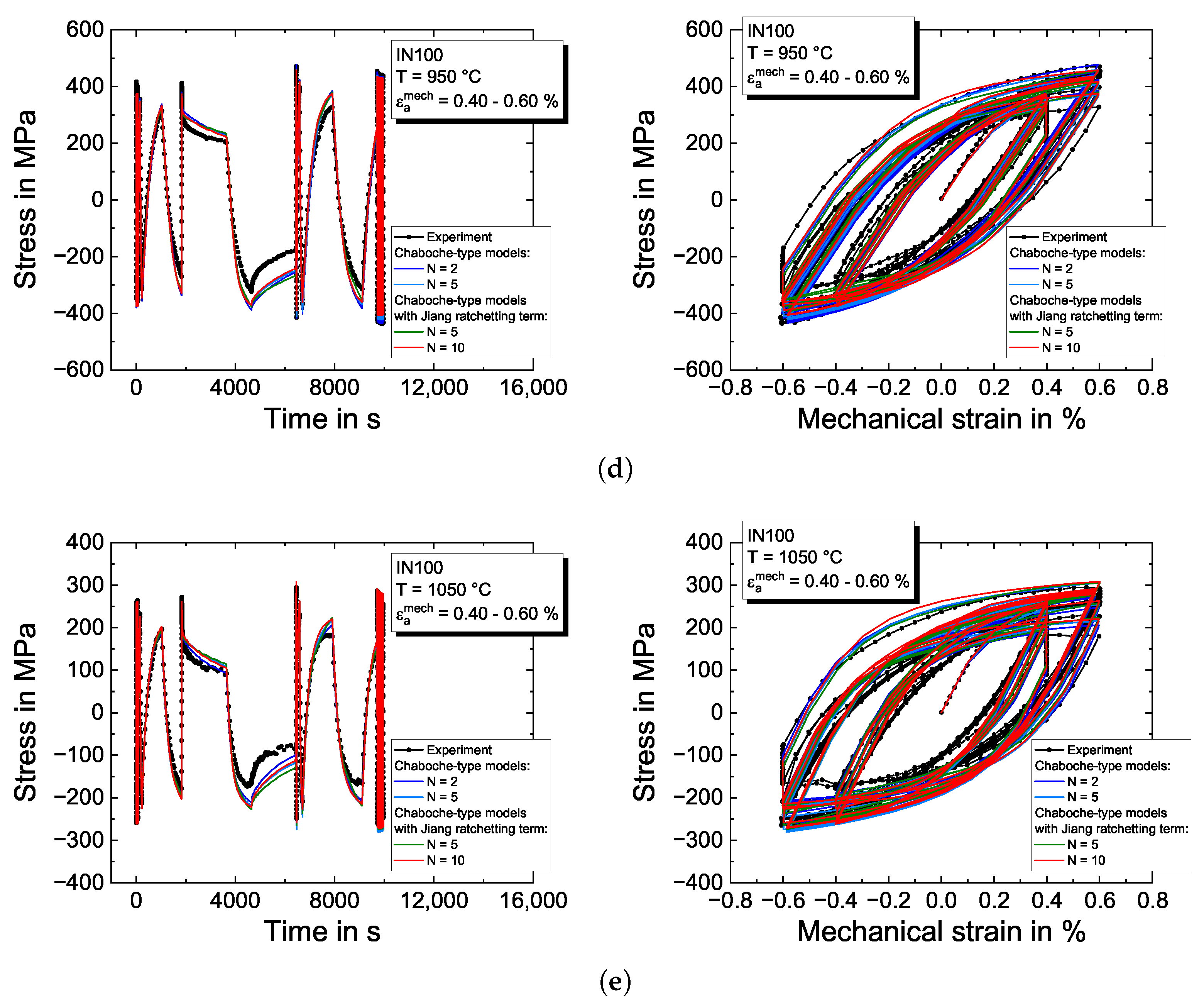
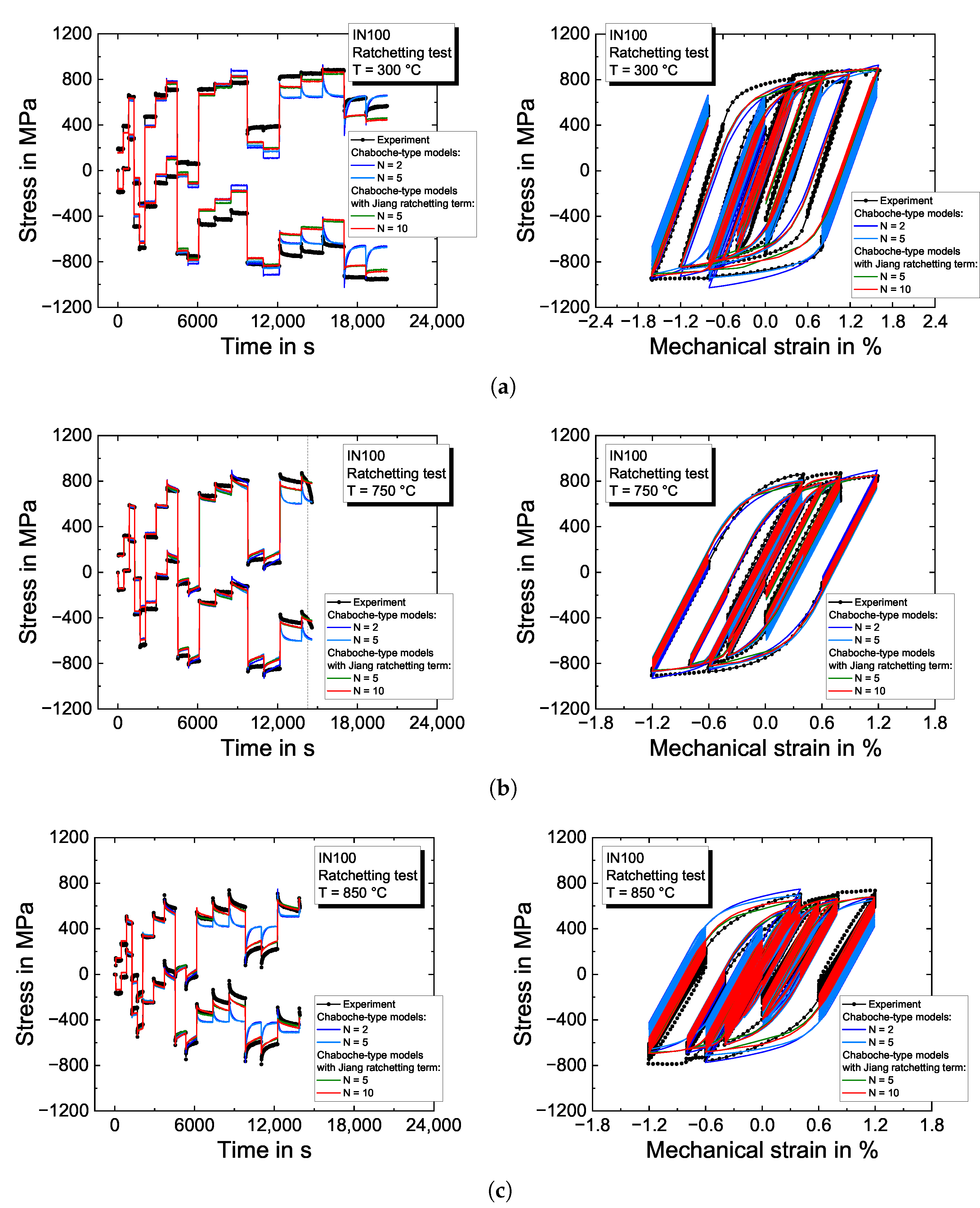


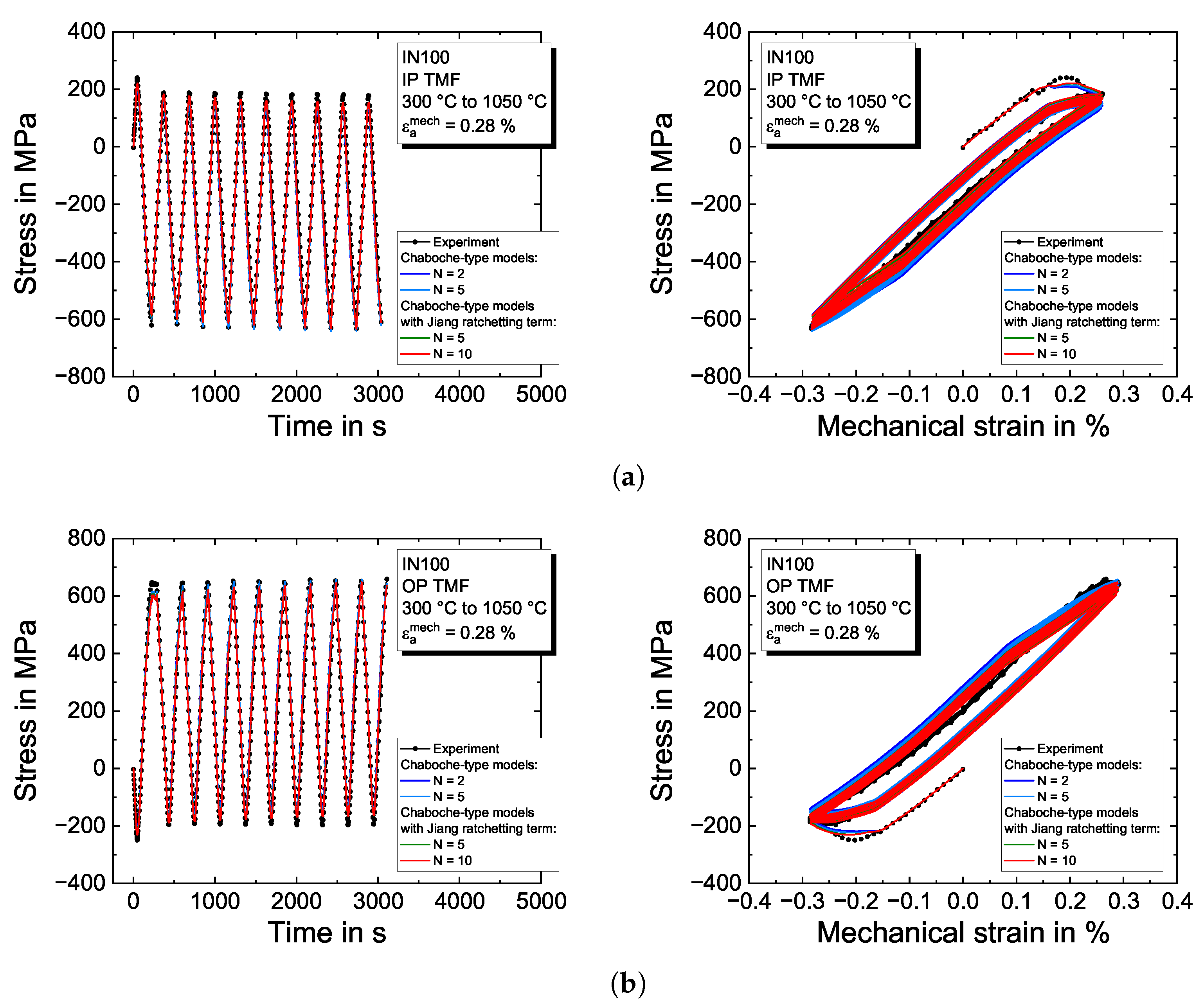

| Co | Cr | Al | Ti | Mo | V | C | Zr | B | S | Fe | Cu | Si | Mn | Ni |
|---|---|---|---|---|---|---|---|---|---|---|---|---|---|---|
| 14.8 | 9.0 | 5.7 | 4.7 | 3.0 | 0.8 | 0.16 | 0.06 | 0.014 | 0.003 | <0.1 | <0.1 | <0.1 | <0.1 | base |
Disclaimer/Publisher’s Note: The statements, opinions and data contained in all publications are solely those of the individual author(s) and contributor(s) and not of MDPI and/or the editor(s). MDPI and/or the editor(s) disclaim responsibility for any injury to people or property resulting from any ideas, methods, instructions or products referred to in the content. |
© 2023 by the authors. Licensee MDPI, Basel, Switzerland. This article is an open access article distributed under the terms and conditions of the Creative Commons Attribution (CC BY) license (https://creativecommons.org/licenses/by/4.0/).
Share and Cite
Fischer, C.; Schackert, S.; Seifert, T.; Schweizer, C.; Fuchs, M. Experiments and Modeling on the Stain-Controlled Time- and Temperature-Dependent Cyclic Ratchetting Plasticity of the Nickel-Based Superalloy IN100. Materials 2023, 16, 1888. https://doi.org/10.3390/ma16051888
Fischer C, Schackert S, Seifert T, Schweizer C, Fuchs M. Experiments and Modeling on the Stain-Controlled Time- and Temperature-Dependent Cyclic Ratchetting Plasticity of the Nickel-Based Superalloy IN100. Materials. 2023; 16(5):1888. https://doi.org/10.3390/ma16051888
Chicago/Turabian StyleFischer, Carl, Sophie Schackert, Thomas Seifert, Christoph Schweizer, and Martin Fuchs. 2023. "Experiments and Modeling on the Stain-Controlled Time- and Temperature-Dependent Cyclic Ratchetting Plasticity of the Nickel-Based Superalloy IN100" Materials 16, no. 5: 1888. https://doi.org/10.3390/ma16051888
APA StyleFischer, C., Schackert, S., Seifert, T., Schweizer, C., & Fuchs, M. (2023). Experiments and Modeling on the Stain-Controlled Time- and Temperature-Dependent Cyclic Ratchetting Plasticity of the Nickel-Based Superalloy IN100. Materials, 16(5), 1888. https://doi.org/10.3390/ma16051888







